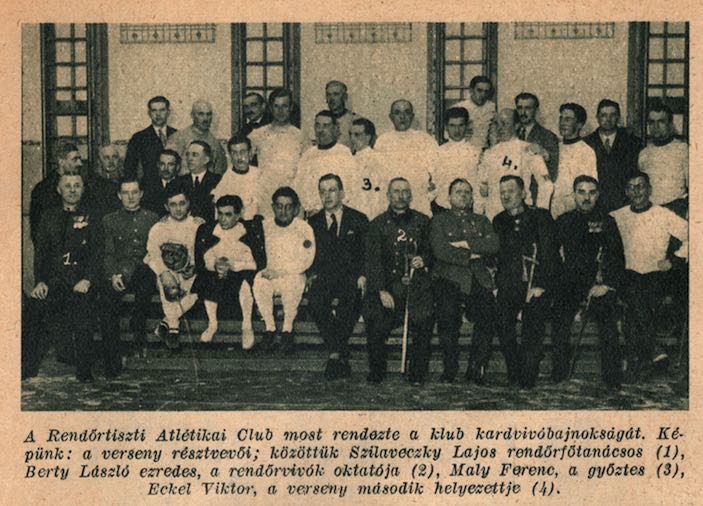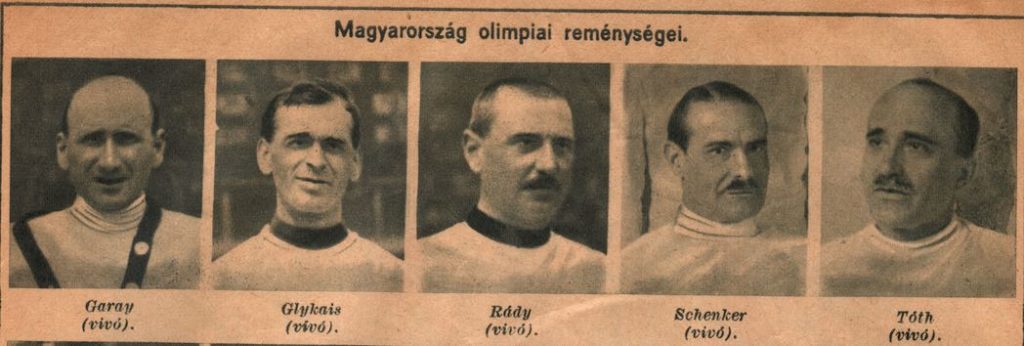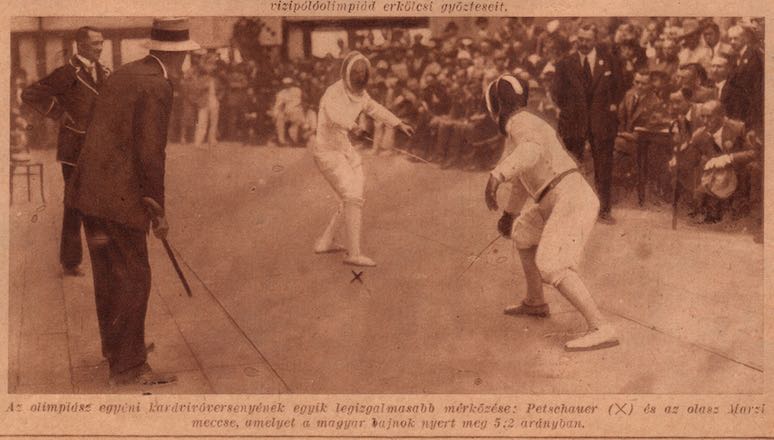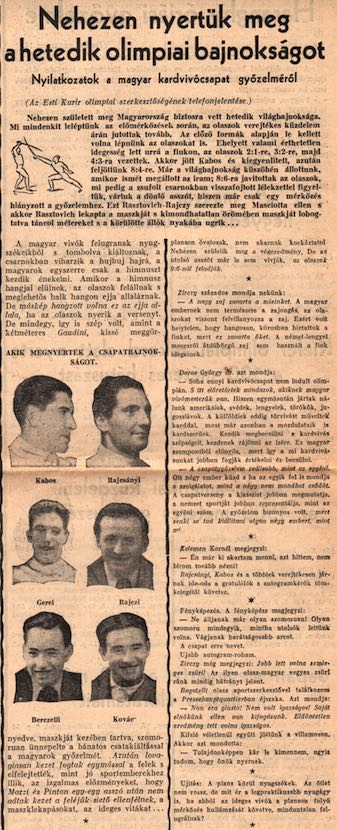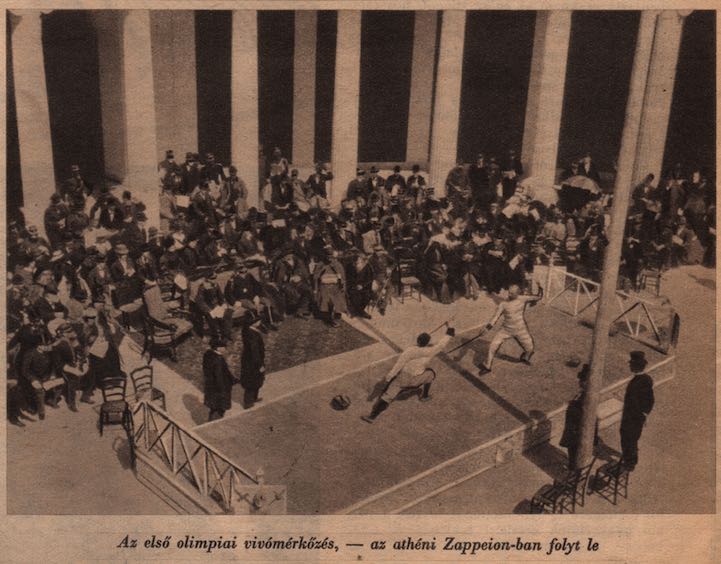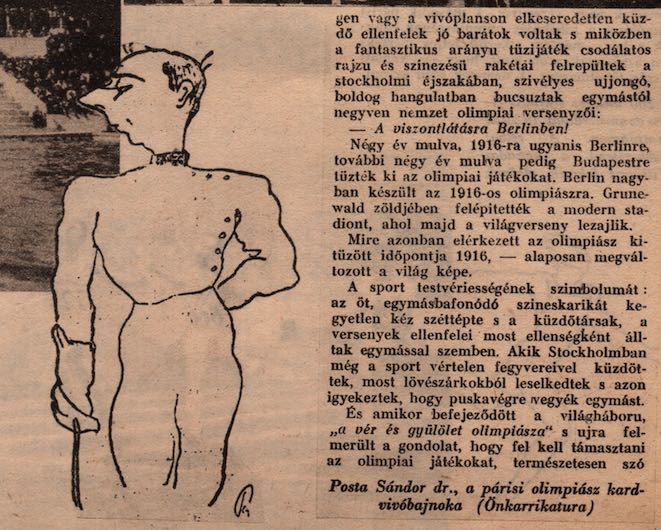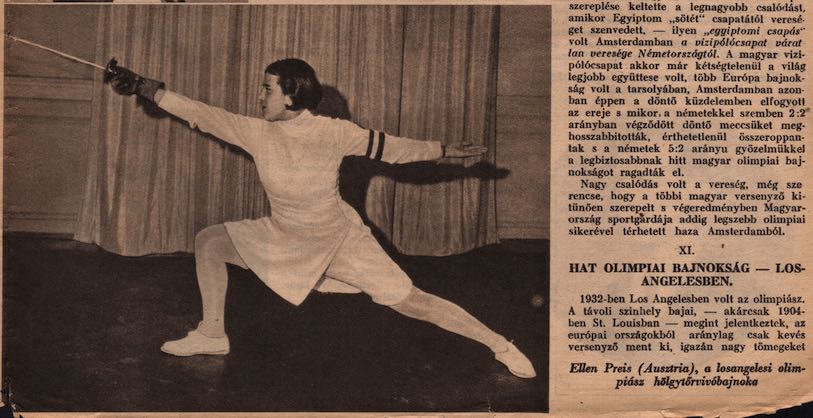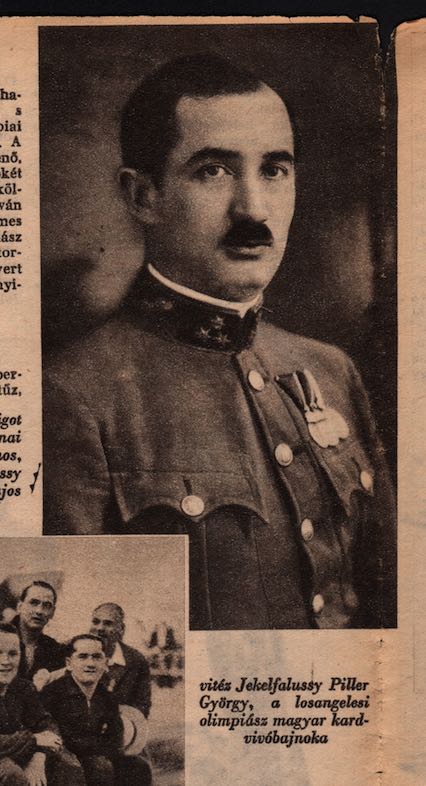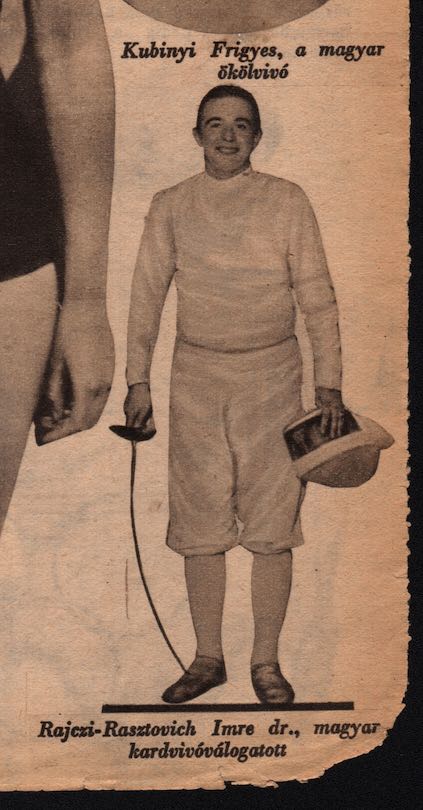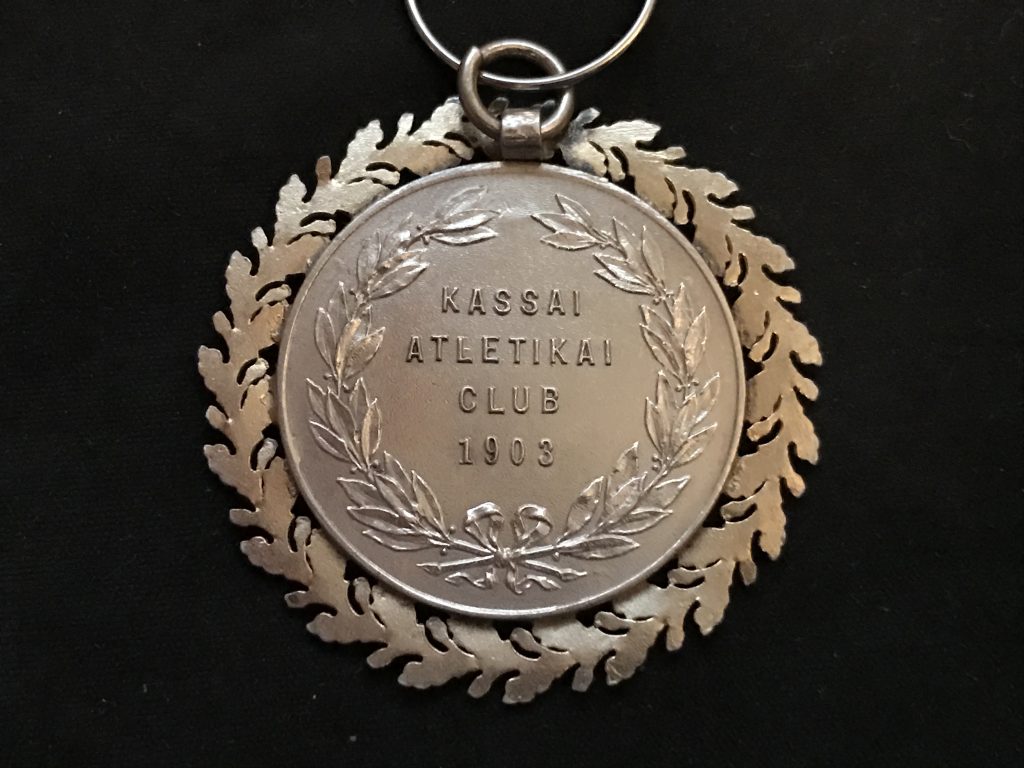While visiting Budapest this past summer to record interviews with a number of people for our forthcoming documentary on fencing great George Piller, we made one very interesting trip to a popular flea market in the southeast of the city, the Ecseri Flea Market. I love flea markets. I get to them less frequently these days, as there aren’t any close by my house. Still, they’re familiar and comforting, in a way. When you get used to the ins and outs of bargaining (or not) and especially if you know what you’re looking for, it can make the experience as close to a hunt for pirate treasure as I’m ever likely to get.
I didn’t know what to expect from a Hungarian flea market, though. I was relieved to discover that it’s as close as can be to any flea market I’ve ever been to in California. The biggest distinction was language. In California, it’s handy to have a little Spanish to communicate. In Hungary, it would have been handy to have a little Hungarian at my disposal. Not a surprise, exactly. My shooter/editor/co-producer/webmaster Greg and I arrived separately from our interpreter and she was running behind, so we just dove in and started wandering through the narrow aisles. The first thing that jumped out at me was the age of the paintings that were common in the first part we saw. Instead of the typical type of home-artist paintings you’d see around here, (no offense intended to you home painters out there) a great number of the paintings we saw were early 1900’s. Lots and lots of older European paintings by unknown, but classically trained, oil painters, often depicting religious scenes and figures. Some really nice paintings, but I wasn’t there to collect paintings – unless they were of famous fencers. The one word that we could say to sellers that would aid us in getting after what we were looking for was “kardvivas”, meaning, more or less, sabre fencing. Nothing really came our way immediately, but I did find a paperback book about the Ludovica school, where Piller’s master, Lazslo Borsodi taught. There’s a photo of Borsodi in the book, so it was a good pickup. Once our interpreter arrived, we had better luck. I found a bronze fencing medal from 1940 – engraved with the date! Not much else came to light, but our interpreter was great at explaining, in much greater detail than our near-lame ‘kardvivas’, exactly what we were looking for. One dealer, with a table full of sports magazines from years past, explained that he had some fencing-related papers or magazines, but not at the market that day. He exchanged cell phone numbers with our interpreter and promised to let her know soon what he had.
We had gone to the flea market shortly after arrival in Budapest – our first Saturday in the city. Over the next week, I sort of forgot about the possibility of getting some old sports papers. The busy daily schedule of travel, setup, interview, tear down, travel, crash, kept my focus on other pursuits. So it was a nice surprise over a week later when Xenia, our translator, showed up with a stack of old newspapers. The dates of the seven papers she scored ranged from 1928 through 1936. Each had at least one photo of someone fencing, or a photo and caption of some fencer or other. Total cost? About $6.
Some of the pictures were easy to interpret. Famous fencers, famous situations, those were simple. Others, well, not so much. I thought for today I’d share the fencing photos I scanned from the pages. There isn’t really anything that helps us much for our documentary, but it’s cool (at least to me) to have these old Hungarian papers with our sport prominently portrayed as a staple part of the daily news of the country. I’ll put them in order of date, oldest first.
The first four are from a paper called the “Pesti Hirlap”, which Google Translate tells me means “The Herald”. A very newspapery title.
From July 29, 1928.
The 1928 Summer Olympics began on July 28th, so this article is part of full page of photos showing some of the Olympians participating for Hungary in Amsterdam. Of the fencers shown, Garay and Glykais were on the sabre team. Rady on the sabre and foil teams, Schenker fenced foil and Toth epee. The first three won gold with the sabre team, but the two stars, Tersztyanszky and Petschauer, didn’t make the paper yet.
From August 14, 1928.
Two days after the close of the Games, Petschauer makes the paper. That’s him with the X under his front foot, fencing against the great two-weapon threat (and Beppe Nadi trained) Gustavo Marzi of Italy. Petschauer was undefeated in the team event in 1928 and dropped only four matches out of 24 in the individual, one being the barrage for Gold against teammate Tersztyanszky. (Tersztyanszky was killed the year following his Olympic triumph in a car crash. He had learned to fence left-handed after sustaining an injury to his dominant right hand in WW1.)
From December 31, 1929.
I shared these magazines with Danny Magay, 1956 Olympic Gold Medal winner, and he told me that the above was a tournament for police officers. No famous names, but they were fencing sabre in Budapest in the late ‘20s, so it’s likely they knew what was what.
From April 20, 1932.
Another police tournament. Referencing Google Translate again, it seems to indicate that “Rendortiszti Atletikai Club” would be “Police Officers Athletic Club”.
This next one, a two-page spread, is from another magazine, this one called “Fuggetlenseg” or “The Independent”. At least, according to GT.
From February 27, 1934.
The fencers in the center left are Endre Kabos on the left and Aladar Gerevich on the right. Both spent their early years training with Italo Santelli. Both were also superstars, but they had very different fates. Kabos was the World Champion in ‘33 and ‘34. Gerevich in ‘35. Kabos won the Olympics in ‘36. Kabos, a Jew forced to do manual labor during WW2, was killed in the Margit Bridge explosion in 1944. The Nazi sappers mistakenly blew up the bridge while they and the foot traffic were still on the bridge. Kabos was returning home across the bridge after a chess match with a friend. He and hundreds others were killed in the explosion. Gerevich, over the course of his career, went on to win two more individual World Championships, an individual Olympic Gold, a total of six Olympic Team Golds and twelve World Championship Team Golds. He was on the Hungarian national sabre team from 1931 to 1960.
Yet another paper yields the next article. “Estikurir” is how this paper is titled. Google Translate would have me believe this paper is called the “Evening Bishop”. I’m going to go ahead and doubt the exactitude of that translation.
From August 15, 1936.
I’m assuming this article, published the day prior to the closing ceremonies of the Berlin Olympics, is boasting of the triumph of the Hungarian sabre fencers. The six fencers pictured make up the Gold medal squad. Kabos, as mentioned previously, won the Gold individual and Gerevich the Bronze. (Gustavo Marzi took the Silver.) One thing to note for those of us keeping score, or just those afflicted with a little OCD (guilty), two of the pictures have their name captions swapped. The bottom row pictures Pal Kovacs on the left and Tibor Berczelly on the right. Just to be, you know, exact. It’s also not clear to me that the column on the right is talking about the column on the left, but I included it anyway.
The final six images are from a single paper. It’s a special edition for the 1936 Olympics and runs through a history of the modern Olympic games, mostly as it relates to Hungarian success.
The first Olympics, held in Athens in 1896, included fencing, as has every succeeding modern Olympic games. Above is a photo of the event for Fencing Masters, showing a demonstration of the Grande Salute.
This photo is the Gold medal Olympic sabre squad from 1908. One interesting piece of trivia we learned on our trip was about the gentleman second from the right, Jeno Fuchs. He won the individual and team Gold at the Olympics in both 1908 and 1912, but never won major Hungarian championships. The reason for this, from what we were told, was that he wasn’t a terribly pleasant man and thus was not welcome in any fencing clubs. Competing in Hungarian championships apparently had a prerequisite of being a member of a participating club. Since he wasn’t a member of a club, no Hungarian championships. Somehow I don’t imagine the lack thereof made his four Olympic Gold medals very lonely. I would guess that having those four would make up for a multitude of slights, real or imagined.
This caricature is of Dr. Sandor Posta, who was coached by both Italo Santelli and Laszlo Gerentser. Interestingly, he is best remembered in Hungarian fencing circles as the man who lost the last bout against the Italians in the team sabre match at the 1924 Olympics, making the bout score 8-8 and giving the Italians the Gold medal on touches received.
A photo of Ellen Preis of Austria, winner of the Gold medal at the 1932 Los Angeles Olympics. Along with Ilona Elek of Hungary and Helene Mayer of Germany, Preis was one of the great women fencers of the 20th century. She won the World Championships 3 times, won two additional Bronze medals at Olympic games and competed until age 44 at the 1956 games where she finished 7th.
Here is the subject of our documentary, Jekelfalussy (Piller) Gyorgy. Piller was his father’s name. A career military officer, he was selected for the Royal Guard after his 1932 Olympic victory. At that time, he took his mother’s name, Jekelfalussy, as it was a more traditionally Hungarian name. He fought in WW1 in Romania and Italy. He lost at least one brother (he had four) and his father to that war. He competed at the 1928 Olympics on the foil and epee teams. After that Games, he switched to sabre and quickly rose to the pinnacle of the international ranks. He won the World Military championship, the Hungarian championship multiple times, the European championship multiple times, the World championship twice and the Olympics in 1932. He retired from competition after 1932, but was called back into the game in ‘33 during the World Championships which, fortunately for the Hungarians, were held in Budapest on Margit Island in the middle of the Danube. Finding themselves one fencer short for the Gold medal match against Italy, Piller – ill at home – was called and asked to hurry to Margrit Island to fence in the team match or the Hungarians would have to forfeit. Down 3-0 in his first bout, someone (multiple attributions) shouted to Piller something along the lines of “have you forgotten how to fence?!” Piller answered something along the lines of, “I was studying!” and went on to win that match 5-3 – along with the rest of his bouts.
Imre Rajczi was on the 1936 sabre team, won the Hungarian championships in 1937 and was a team member of a couple World Championship teams. Rajczi was coached by the great university instructor, Laszlo Gerentser, who was also the coach of Csaba Elthes. He moved his family to Argentina in 1945 and was the Argentine national coach for 10 years.
I’ve never had such good luck finding fencing memorabilia at (or through the auspices of) a flea market before. I will confess that I once found a Hungarian fencing medal at the Skyview Drive In Flea Market in Santa Cruz, CA. This was in 1978 and I was a poor student. There were two medals, but I could only afford to buy one of them. I’ve still got it:
It’s a beautiful thing, isn’t it? I wish I had a photo of the one that got away, but I really only remember that this was the nicer of the two. How it wound up at a flea market in Santa Cruz, I can’t begin to imagine.
I digress, naturally. It’s what I do best. The point: Budapest. Flea market. Win!

